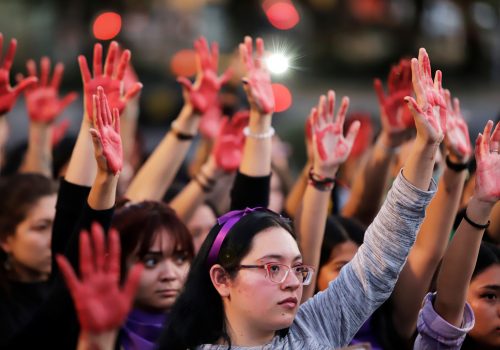Closing gender gaps is not just a moral imperative; it’s good for business. Greater gender equality in education, health, economics, and politics leads to economic growth, reduced income inequality and poverty, and improved business outcomes.
Yet, significant lags in women’s economic and political empowerment remain in countries like Colombia. Having closed educational attainment and health and survival gaps almost entirely, the country still faces important gender gaps in economic participation and opportunity (a gap of 26.5 percent) and in political empowerment (a gap of 68.2 percent). If Colombia doubles-down on its efforts to close these gaps, numerous economic and social benefits will follow.
Why should Colombia prioritize closing its gender gap in economic participation?
Gender parity promotes economic growth. At a basic level, greater gender equality in economic participation and opportunity will boost growth by expanding the size of Colombia’s labor force, which will, in turn, increase output. Currently, women’s potential economic contribution in Colombia remains untapped, with 62.9 percent of women aged fifteen to sixty-four participating in the labor force, compared to 85.1 percent of men in the same age bracket. According to PricewaterhouseCoopers, if all thirty-six member countries of the Organization for Economic Co-operation and Development (OECD)—of which Colombia is set to become a member—increase their female labor force participation rate to match that of Sweden (80 percent), global gross domestic product (GDP) will rise by over $6 trillion.
An increase in women’s labor force participation will also enhance aggregate productivity by fostering new ideas for production and management. Women bring different perspectives and aptitudes to the table, which makes their work complementary, rather than a perfect substitute to that of men. Hence, increasing the number of women in Colombia’s workforce should contribute greater economic benefits than an equivalent increase in the number of men. Additionally, young women (aged twenty-five to thirty-four) have greater educational attainment than young men in Colombia, which incentivizes increased female labor force participation to deepen Colombia’s talent pool, leading to a more efficient allocation of resources, gains in income and total factor productivity, and higher output growth.
Closing Colombia’s gender gap in economic participation will also help reduce income inequality and poverty. Gender inequality usually comes hand-in-hand with income inequality, which compromises the sustainability of growth. Disparities in wages and labor force participation between men and women increase income inequality and yield unequal access to pensions and social benefits. In Colombia, wage and unemployment gaps both stand at 5.8 percent, with women earning less than men in similar positions and facing higher unemployment rates regardless of their education level. Women are also more likely to work in the informal sector, earning less and receiving no social benefits.
In the early 2000s, poverty fell significantly in Latin America due, in part, to increased labor market earnings and participation rates for women (along with the implementation of noncontributory pensions for women), suggesting that promoting women’s economic inclusion can further this drop in poverty. This will also lead to other positive human development outcomes, given that women’s labor force participation is correlated with higher expenditure on schooling and health for children, which supports poverty reduction, increased productivity, and long-term economic growth.
Greater gender equality also improves business outcomes. A 2019 International Labor Organization (ILO) study shows that firms with a gender inclusive business culture and gender-friendly policies are more likely to have increased productivity and profits; enhanced talent retention; greater creativity, innovation, and openness; improved company reputation; and a better sense of consumer interest and demand. In a similar study, McKinsey & Company found that companies in the top quartile for gender diversity are fifteen percent more likely to have higher financial returns than their competitors. Also, according to ILO, firms with female chief executive officers (CEOs) are 3.5 percent more likely to have increased productivity and profits, resulting in higher potential output. Evidence from Europe suggests that including one more woman in senior management or corporate boards (without changing the size of senior teams) yields higher returns on assets of eight to thirteen basis points.
Colombia has made significant progress toward promoting women in senior roles, with OECD statistics reporting that women hold 57 percent of managerial positions in the country. Although this statistic reflects important improvement, it does not accurately depict the whole picture. Full gender parity in senior roles has yet to be achieved— women in Colombia usually oversee areas that are arguably less central to the work of the organization like human resources, public relations, communications, and administration. Women remain underrepresented in managerial positions in areas traditionally and stereotypically reserved for men like research, product development, operations, and sales.
Research shows that policies matter for women’s employment decisions even after controlling for personal preferences toward work. Most of these policies will pay for themselves in the medium and long term, as Colombia begins to reap the economic and social benefits of gender parity.
Here are five ways in which Colombia can promote gender equality and women’s economic empowerment:
- Increasing access to infrastructure and public services. Investing in infrastructure (e.g. better roads and networks) will allow for more women to access work and for more girls to attend school. Also, investing in public services like electricity, water, and sanitation will increase women’s participation in the workforce and boost school attendance among young women. The burden of unpaid domestic work, intensified by the absence of adequate services, falls disproportionately on women and girls. In Colombia, 89.5 percent of women and girls (aged ten or more) engage in unpaid domestic and care work in comparison to 62.0 percent of their male counterparts. On average, women and girls devote twice as much time as men and boys to unpaid work— women and girls spend 50 hours per week or 7.14 hours per day in unpaid work while men and boys dedicate 22.8 hours per week or 3.35 hours per day. Improving access to quality public services will free up time for girls and women to participate in the economy or attend school.
- Promoting financial and digital inclusion. Increasing women’s access to digital technology, financial services, microfinance, and mobile banking, and improving financial literacy among young women, leads to higher female labor force participation, entrepreneurship, and productivity. It also promotes female presence in leadership roles and reduces gender gaps in income, borrowing rates, and time spent doing unpaid work. Digital inclusion is of heightened importance in a country where 23 million Colombians—almost 50 percent of the country—do not have internet access.
- Cash transfers to low-income women. Providing cash transfers to low- and middle-income women working in the formal or informal market can increase female labor force participation, boosting potential output, while reducing poverty and wage and income gaps in the short and long run. Previous CCT programs in Colombia have been successful in reducing poverty and mitigating income inequality, such as the Familias en Accion CCT program, which provided conditional cash transfers to vulnerable families complying with healthcare and education commitments, effectively improving children’s health, nutrition, and educational attainment.
- Closing gender gaps in political participation. Although Colombia has its first female vice president and a ministerial cabinet with gender parity, several barriers to women’s political participation in Colombia remain. Gender gaps are most evident at the departmental and municipal level, as only two out of thirty departments (6.25 percent) and 132 out of 1,101 municipalities (12.0 percent) are governed by a woman. Evidence suggests that women’s participation in politics contributes to increased supply of and demand for economic opportunities for women, which boosts female labor force participation and fosters economic growth. Additionally, promoting women’s political empowerment leads to more just, equitable, and peaceful societies.
- Promoting gender-transformative education. Investing in education is the most effective way to boost women’s human capital and shape future labor force productivity. Colombia has improved remarkably in this front, but the country’s lingering economic, social, and political gender gaps demonstrate that exclusively focusing on girls’ educational attainment does not address deep structures of gender inequality reinforced in and through education. Colombia must therefore work to provide quality education for all and include gender-transformative initiatives in school curriculums. Growing evidence shows that quality education plays a critical role in transforming boys’ and men’s attitudes and behaviors in terms of gender equality. When boys and young men have higher educational attainment and are empowered to challenge and overcome discriminatory gender norms, they display more gender equitable attitudes and practices. Among other outcomes, they become less likely to violently abuse an intimate partner and have homophobic attitudes, are more likely to share unpaid domestic and care work, and have better sexual and reproductive health practices. Focusing on harmful gender norms that disadvantage both girls and boys will push Colombia forward in its path toward gender equality.
Camila Hernandez is an assistant director at the Adrienne Arsht Latin America Center at the Atlantic Council. Follow her on Twitter @CHernandezGB.
Further reading:
Image: An employee examines cotton thread inside a workshop of textile factory Faricato, in Bello, Antioquia province April 12, 2011. The U.S. may send a long-delayed free trade pact with Colombia to Congress for approval within weeks now that a bilateral agreement on labor concerns has been reached. Colombian companies such as Fabricato may benefit from the agreement. REUTERS/Albeiro Lopera



